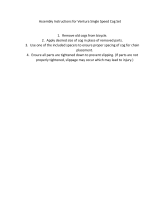
18 4/3/01
CDMA 800/1900
Frequency Synthesizer Circuitry
The phone contains three PLL frequency
synthesizers in the IF/Synthesizer IC U700.
One synthesizer controls the tunable 978-
1004 MHz main local oscillator, U680 and
the tunable 1019MHz - 1050MHz main local
oscillator for PCS 1900 mode. The second
synthesizer controls the TX offset oscillator
(internal to U700) which operates at a fixed
frequency of 309.3 MHz for AMPS, and
309.6 MHz for CDMA. The TX offset signal
is divided by 2 before going to the TX mixer.
TX modulation occurs in the TX offset syn-
thesizer in AMPS mode. The third synthe-
sizer (also internal to U700) operates at a
fixed frequency of 219.3 MHz for AMPS,
219.8 MHz for CDMA. This oscillator is
divided by 2 and used to mix the received
first IF signal down to baseband. All synthe-
sizers obtain their frequency reference from
the 16.8 MHz reference oscillator, U325.
Transmit Power Control Circuitry
The power control signal controls voltage
controlled attenuator U600 which is the TX
mixer. A detected sample of the TX output
signal with a variable reference voltage. A
closed loop adjusts the Power Control signal
such that the sampled RF signal level
matches the reference level. In AMPS mode,
the RF power range is +8 dBm to +28 dBM.
In CDMA mode the RF power range is -50
dBm to +24 dBm. In CDMA mode, the
power control can operate in either open-
loop or closed-loop modes. In open-loop
mode, the power level is proportional to the
received signal level. In closed loop mode,
the power level is controlled by the CDMA
cell, based on received signal strength at the
cell site.
Receive Audio - AMPS Mode
AMPS discriminator audio is routed to
U1900 to be digitized. All receive audio fil-
tering and gain control is performed in the
digital domain by DSP U1100. The pro-
cessed RX
audio is converted back to analog by U1900
and amplified by the GCAP IC U2000. The
received audio is then routed to either the
boom speaker or internal earpiece speaker.
Receive Audio - CDMA Mode
Received CDMA OQPSK data (RX I, RX Q)
is gain controlled and converted to digital by
U1900. The 1.2288 Mb/sec. RX data stream
is then decoded by the U1100 Modem IC to
produce a signal containing only the desired
data. The digital speech data is routed
through the microprocessor U1100, decoded
by the U1100 CELP Vocoder, and sent to
U1900 to be converted into analog audio.
The audio signal is then amplified by U2000
and sent to the earpiece speaker.
Transmit Audio - AMPS Mode
Audio from the internal microphone is
ampli-fied
and converted to data by U1900. In AMPS
mode, the digitized microphone audio is then
sent to DSP U1100 which performs all com-
pression, pre-emphasis, limiting, and band-
pass filtering functions in the digital domain.
All AMPS signalling (SAT, ST, DTMF) is
also generated in the digital domain by DSP
U1100. The digitized AMPS TX audio signal
is converted back to analog by the U1900
and sent to the 154.65 MHz TX Offset VCO
to modulate the transmitter.




















